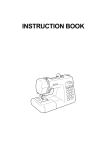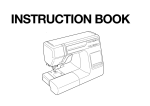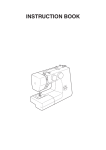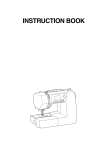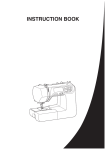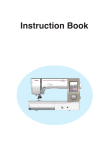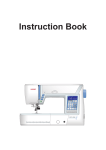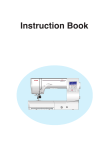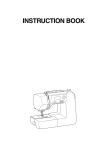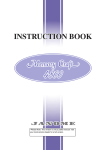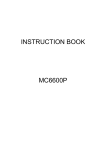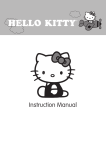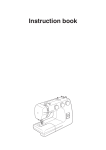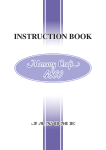Download JANOME DC5100 Instruction Booklet
Transcript
Instruction book IMPORTANT SAFETY INSTRUCTIONS This appliance is not intended for use by persons (including children) with reduced physical, sensory or mental capabilities, or lack of experience and knowledge, unless they have been given supervision or instruction concerning use of the appliance by a person responsible for their safety. Children should be supervised to ensure that they do not play with this sewing machine. When using an electrical appliance, basic safety precautions should always be followed, including the following: This sewing machine is designed and manufactured for household use only. Read all instructions before using this sewing machine. DANGER — To reduce the risk of electric shock: 1. An appliance should never be left unattended when plugged in. Always unplug this sewing machine from the electric outlet immediately after using and before cleaning. 2. Always unplug before replacing a sewing machine bulb. Replace bulb with same type rated 5 Watts. WARNING — To reduce the risk of burns, fire, electric shock, or injury to persons: 1. Do not allow to be used as a toy. Close attention is necessary when this sewing machine is used by or near children. 2. Use this appliance only for its intended use as described in this owner’s manual. Use only attachments recommended by the manufacturer as contained in this owner’s manual. 3. Never operate this sewing machine if it has a damaged cord or plug, if it is not working properly, if it has been dropped or damaged, or dropped into water. Return this sewing machine to the nearest authorized dealer or service center for examination, repair, electrical or mechanical adjustment. 4. Never operate the appliance with any air opening blocked. Keep ventilation openings of this sewing machine and foot controller free from accumulation of lint, dust and loose cloth. 5. Never drop or insert any object into any opening. 6. Do not use outdoors. 7. Do not operate where aerosol (spray) products are being used or where oxygen is being administered. 8. To disconnect, turn all controls to the off (“O”) position, then remove plug from outlet. 9. Do not unplug by pulling on cord. To unplug, grasp the plug, not the cord. 10. Keep fingers away from all moving parts. Special care is required around the sewing machine needle and/or cutting blade. 11. Always use the proper needle plate. The wrong plate can cause the needle to break. 12. Do not use bent needles. 13. Do not pull or push fabric while stitching. It may deflect the needle causing it to break. 14. Switch this sewing machine off (“O”) when making any adjustment in the needle area, such as threading the needle, changing the needle, threading the bobbin or changing the presser foot, and the like. 15. Always unplug this sewing machine from the electrical outlet when removing covers, lubricating, or when making any other adjustments mentioned in this owner’s manual. SAVE THESE INSTRUCTIONS The design and specifications are subject to change without a prior notice. Please note that on disposal, this product must be safely recycled in accordance with relevant National legislation relating to electrical/electronic products. If in doubt please contact your retailer for guidance. (European Union only) I TABLE OF CONTENTS SECTION I. NAME OF PARTS Names of parts ................................................................. 2 Standard accessories ...................................................... 3 Adjust the needle thread tension for a zigzag stitch ....... • Correct tension ...................................................... • Tension is too tight ................................................. • Tension is too loose ............................................... SECTION II. GETTING READY TO SEW Connecting machine to power supply .............................. 4 Before using your sewing machine .................................. 4 For your safety ................................................................. 4 Controlling sewing speed ................................................. 4 Speed control lever .......................................................... 5 Machine operating buttons ........................................... 5–7 Up/down needle position button ................................ 5 Auto-lock button ......................................................... 5 Reverse stitch button ................................................. 5 Screen sharpness adjusting dial ................................ 5 Cursor keys ................................................................ 6 Mode key ................................................................... 6 Stitch width selection key ........................................... 6 Stitch length selection key ......................................... 6 Memory key ............................................................... 7 Clear key .................................................................... 7 Function touchpad ..................................................... 7 • Direct pattern selection ..................................... 7 • Number keys ..................................................... 7 Pattern selection and screen indication ........................... 8 Number key selection ....................................................... 8 Language selection .......................................................... 9 Presser foot lifter ............................................................ 10 Thread cutter .................................................................. 10 Extension table ............................................................... 10 • Detaching the table ............................................... 10 • Attaching the table ................................................. 10 • Accessory box ....................................................... 10 Changing needle ............................................................ 11 To remove and attach the foot holder ............................. 11 • To remove .............................................................. 11 • To attach ................................................................ 11 Changing presser foot .................................................... 11 • To remove .............................................................. 11 • To attach ................................................................ 11 Selecting thread and needles ......................................... 12 Bobbin winding ......................................................... 13–15 • Removing the bobbin ............................................ 13 • Horizontal spool pin ............................................... 13 • Additional spool pin ............................................... 13 • Winding the bobbin ................................................ 14 • Inserting the bobbin ............................................... 15 Threading the machine ............................................ 16–17 • Threading the machine .......................................... 16 • Needle threader ..................................................... 16 • Drawing up bobbin thread ..................................... 17 Adjust the needle thread tension for a straight stitch ..... 17 • Correct tension ...................................................... 17 • Tension is too tight ................................................. 17 • Tension is too loose ............................................... 18 18 18 18 18 SECTION III. BASIC SEWING Straight stitch ................................................................. 19 • Starting to sew ....................................................... 19 • Changing sewing direction .................................... 19 • Finishing sewing .................................................... 19 Using the seam guides on the needle plate ................... 20 Turn a square corner ...................................................... 20 Quilting .......................................................................... 22 Sewing on heavy fabrics ................................................ 21 Manual stitch length ....................................................... 21 Variable needle position ................................................. 21 To drop or raise the feed dog ......................................... 22 Basting .......................................................................... 22 • Attaching the darning foot ..................................... 22 • To sew ................................................................... 22 Quiliting with walking foot ............................................... 23 Automatic reverse stitch ................................................. 24 Triple stretch stitch ......................................................... 24 Straight stretch ............................................................... 24 Auto-lock stitch ............................................................... 25 Saddle stitch ................................................................... 25 Zigzag stitch ................................................................... 25 • To change the width and length ............................. 25 Overcasting .................................................................... 26 Tricot stitch ..................................................................... 26 Knit stitch ........................................................................ 26 Overedge stitch .............................................................. 27 Double overedge stitch ................................................... 27 Button sewing ................................................................. 28 Automatic buttonhole................................................ 29–31 • Preparation for sewing ..................................... 29–30 • Starting to sew ....................................................... 30 Adjusting the stitch width and density in buttonholes ..... 31 • To change the stitch width ..................................... 31 • To change the stitch density .................................. 31 Round end buttonhole .................................................... 31 Keyhole buttonhole ......................................................... 31 Stretch buttonhole .......................................................... 32 Knit buttonhole ............................................................... 32 Adjusting the stitch width and density in round end, keyhole, stretch and knit buttonholes ............................. 32 • To change the stitch density .................................. 32 • Adjustment of the stitch width on rounded end buttonhole .............................................................. 32 • Adjustment of the stitch width on keyhole buttonhole .............................................................. 32 • Adjustment of the stitch width on stretch and knit buttonhole .............................................................. 32 Corded buttonhole .......................................................... 33 II TABLE OF CONTENTS Eyelet ............................................................................. 34 • To sew ................................................................... 34 Zipper sewing ........................................................... 35–36 • Attaching the zipper foot ........................................ 35 • Fabric preparation ................................................. 35 • To sew ............................................................. 35–36 Darning stitch ................................................................. 37 • To sew ................................................................... 37 • For darning less than 3/4˝ (2 cm) .......................... 37 • To adjust the shape of darning stitch ..................... 37 • To memorize darning stitch .................................... 37 Bartacking ...................................................................... 38 • Memorizing bartacking .......................................... 38 • Adjusting the evenness of bartacking .................... 38 Blind hem stitch .............................................................. 39 • To sew ................................................................... 39 Pintucking ....................................................................... 39 Shell stitch ...................................................................... 40 Applique ......................................................................... 40 SECTION IV. DECORATIVE STITCHING Smocking ....................................................................... • To sew ................................................................... Fagoting ......................................................................... Scallop stitch (A) ............................................................ • To sew ................................................................... Scallop stitch(B) ............................................................. • To sew ................................................................... Patchwork ...................................................................... • To sew ................................................................... Satin stitch ...................................................................... Cross stitch .................................................................... Sand stitch ..................................................................... • To sew ................................................................... Decorative stitch ............................................................. Twin needle stitch ........................................................... Adjusting pattern balance .............................................. Adjusting distorted stretch stitch patterns ...................... Adjusting distorted letters or numbers ........................... Extender stitch combination ........................................... Programming decorative stitch patterns ......................... Sewing letters ................................................................. Editing function ............................................................... Deleting a stitch pattern, letter or number by editing ...... Adding a letter or space between letters ........................ 41 41 41 42 42 42 42 43 43 43 44 44 44 44 45 46 46 46 47 48 49 50 50 51 SECTION V. CARE OF YOUR MACHINE Clean the hook race and feed dogs ............................... Assemble the hook race ................................................. Removing the light bulb .................................................. Attaching the light bulb ................................................... Troubleshooting .............................................................. 52 52 53 53 54 III SECTION I. NAME OF PARTS Names of parts q Extension table (Accessory box) w Needle plate e Needle threader r Thread cutter t Face cover y Thread take-up lever u Upper thread guide i Thread tension dial o Spool pin !0 Large spool holder !1 Flip top stitch chart !2 Screen sharpness adjusting dial !3 Liquid crystal display !4 Function touchpad !5 Speed control lever !6 Up/down needle position button !7 Auto-lock button !8 Reverse stitch button !9 Feed balancing dial @0 Hook cover release button @1 Hook cover plate @2 Foot holder @3 Presser foot @4 Needle @5 Needle clamp screw @6 Thumb screw @7 Machine sockets @8 Power switch @9 Handwheel #0 Bobbin winder stopper #1 Bobbin winder spindle #2 Carrying handle #3 Hole for additional spool pin #4 Presser foot lifter #5 Buttonhole lever #6 Free-arm #7 Drop feed dog lever #8 Nomenclature plate #9 Power supply cord $0 Foot control $1 Hard cover u o i !0 !1 y !2 !3 !4 t r !5 e w q !6 !7 @1 !8 @5 !9 @0 @4 @6 @3 #2 @2 #1 #0 #3 #4 @9 #5 #6 @8 #7 @7 #8 $1 #9 2 $0 Standard accessories q q w e r t y u i o !0 !1 !2 !3 !4 !5 !6 !7 !8 !9 @0 @1 @2 Bobbin Spool pin felt Assorted needle set Additional spool pin Straight stitch foot Zigzag foot (set on the machine) Satin stitch foot Zipper foot Automatic buttonhole foot Overedge foot Blind hem foot Darning foot 1/4˝ seam foot Walking foot Quilter Seam ripper/Buttonhole opener Large screwdriver Lint brush Large spool holder Small spool holder Spool stand Foot control y !1 !6 @1 3 w u e i !2 o !3 !7 @2 r !0 !4 !8 t !5 !9 @0 SECTION II. GETTING READY TO SEW Connecting machine to power supply q Foot control plug w Machine plug e Power supply plug r Power switch t Power supply cord y Foot control Before connecting the power cord, make sure the voltage and frequency shown on the machine conform to your electrical power. r 1. Turn off the power switch r. 2. Insert the foot control plug q, machine plug w into the machine. 3. Insert the power supply plug e into the outlet. 4. Turn on the power switch r. w Before using your sewing machine Before using your sewing machine for the first time, place a waste fabric under the presser foot and run the machine without thread for a few minutes. Wipe away any oil which may appear. q y t For your safety * While in operation, always keep your eyes on the sewing area. Do not touch any moving parts such as the thread take-up lever, handwheel or needle. * Always turn off the power switch and unplug from the power supply: - When leaving the machine unattended. - When attaching or removing any parts. - When cleaning the machine. * Do not place anything on the foot control, when not sewing. e Controlling sewing speed Sewing speed is varied by the foot control. The further down you press on the foot control, the faster the machine runs. Operating instrucitons: This appliance has a polarized plug (one blade wider than the other). To reduce the risk of electric shock, this plug is intended to fit in a polarized outlet only one way. If the plug does not fit in the outlet, reverse the plug. If it still does not fit, contact a qualified electrician to install the proper outlet. Do not modify the plug in any way. Foot control model YC-542 is used with this sewing machine. 4 Speed control lever Sewing speed can be varied by the speed control lever according to your sewing needs. To increase sewing speed, slide the lever to the right. To decrease sewing speed, slide the lever to the left. Machine operating buttons r q Up/down needle position button w Auto-lock button e Reverse stitch button r Screen sharpness adjusting dial q w e Up/down needle position button q q Up/down needle position button Press this button to set the needle position up or down when the machine stops. Auto-lock button w Auto-lock button When stitches are selected, the machine will immediately sew locking stitches when the Auto-lock button is pressed, then automatically stop. When sewing all other stitches, the machine will sew locking stitches at the end of the current pattern and automatically stop. w Reverse stitch button e Reverse stitch button 1 4 5 11 30 e 31 When stitches are selected, the machine will sew in reverse while the reverse stitch button is pressed. If you press the reverse stitch button when sewing all other stitches, the machine will immediately sew locking stitches and automatically stop. 3 3 Screen sharpness adjusting dial r Screen sharpness adjusting dial r Use this dial to adjust the sharpness of the liquid crystal display. If the screen is blank after you switch on the power, adjust the screen brightness with this dial. 5 Machine operating buttons (continued) t t Cursor keys y Mode key u Stitch width selection key i Stitch length selection key u t Cursor keys t Cursor keys Use these keys to check and correct pattern combinations before sewing. For editing, use these keys to select editing position. y Mode key y Mode key When the power switch is turned on, the direct pattern selection is set automatically. Press the mode key to change the mode. z Mode 1 (Black mode): Direct pattern selection x Mode 2 (Blue mode): Utility and decorative stitch pattern selection c Mode 3 (Red mode): Number and block letter selection z x * The triangle mark ( ) on the screen indicates the selected mode number. c Stitch width selection key u WIDTH i LENGTH u Stitch width selection key Press “+” or “–” to change the stitch width. Stitch length selection key i Stitch length selection key Press “+” or “–” to change the stitch length. 6 y i Machine operating buttons (continued) o Memory key !0 Clear key !1 Function touchpad !1 o o Memory key o Memory key The memory key will memorize your pattern selection. Press the memory key after you selected your stitch pattern. (You can program up to 50 patterns in memory.) * The following patterns cannot be memorized. MEM * The machine cannot memorize stitch patterns in mode 1. Use mode 2 or 3 to memorize the stitch patterns. Clear key !0 !0 Clear key If an incorrect pattern is memorized, pressing this key will immediately clear it (like a backspace key). CLR !1 Function touchpad !1 Function touchpad • Direct pattern selection You can select the stitch patterns from 00 to 09 directly in mode 1 (direct pattern selection mode). • Number keys Enter the 2-digit pattern number to select the desired stitch pattern in mode 2 and 3. 7 !0 Pattern selection and screen indication You can select these patterns directly by pressing the pattern keys. The following patterns can be selected simply by pressing the pattern keys. z z When the power switch is turned on, the mode 1 is set automatically. x Press pattern key 4. c The display shows following information: q Stitch pattern: w Presser foot: e Stitch width: r Stitch length: t Mode: x 04 A: Zigzag foot 5.0 2.0 1 c Number key selection You can select the stitch patterns by pressing number keys. This function cannot be used in direct pattern selection mode (mode 1). Example: pattern number 28 z z Select mode 2 (Utility and decorative stitch pattern selection). x Press the number key on the function touchpad. Example: Pattern 28, as shown. c Now the pattern 28 is selected. x c 8 q w e r t Language selection z q Power switch w Memory key e English r French t Spanish z Turn on the power switch q while pressing the memory key w. MEM q w e x You can select the language (English, Spanish or French) by pressing the key or number keys. x r t c Press the memory key w to set the language. c 9 MEM Presser foot lifter q Presser foot lifter w Normal up position e Highest position The presser foot lifter q raises and lowers the presser foot. You can raise it about 1/4˝ (0.6 cm) higher than the normal up position w for easy removal of the presser foot, or to help you place thick material under the foot. e w w e q Thread cutter q Thread cutter q You do not need a pair of scissors to cut the thread after sewing. Simply use the built-in thread cutter. Extension table • Detaching the table Pull the table away from the machine, as illustrated, for “free-arm” sewing of cuffs and sleeves. • Attaching the table Push the extension table until it snaps into the machine. q Extension table w Pin e Hole r Free-arm • Accessory box Open the cover of the accessory box toward you. The sewing accessories are conveniently located in the box. r w e q 10 Changing needle q Needle clamp screw w Needle clamp z Turn off the power switch. Raise the needle to its highest position by turning the handwheel counterclockwise, toward you, and lowering the presser foot. Loosen the needle clamp screw q by turning it counterclockwise. Remove the needle from the needle clamp w. x Insert a new needle into the needle clamp w with the flat side to the rear. When inserting the needle into the needle clamp w, push it up as far as it goes. Tighten the needle clamp screw q firmly by turning it clockwise. c To see if the needle is good, place the flat side of the needle onto something flat (needle plate, glass, etc.). The gap between the needle and the flat surface should be consistent. Never use a bent or blunt needle. A damaged needle can cause permanent snags or runs in knits, fine silks and silk-like fabrics. Flat side Lado plano Méplat vers z q Needle Aguja Aiguille x w c To remove and attach the foot holder q Thumb screw w Foot holder e Presser bar • To remove Remove the thumb screw q by turning it counterclockwise with a screwdriver. • To attach Match the hole in the foot holder w with the threaded hole in the presser bar e. Fit the thumb screw q into the hole. Tighten the screw q by turning it clockwise with a screwdriver. w q e q Changing presser foot q Snap-on button (red button) w Groove e Pin • To remove Raise the needle to its highest position by turning the handwheel counterclockwise. Raise the presser foot, and press the red button q on the back of the foot holder. • To attach Place the selected presser foot so that the pin e on the foot lies just under the groove w on the foot holder. Lower the presser bar to lock the foot into place. q w 11 e Selecting Thread and Needles For general sewing, use needle size 11/75 or 14/90. A fine thread and needle should be used for sewing lightweight fabrics, so the fabric will no be marred. Heavy fabrics requires a needle large enough to the fabric without fraying the needle thread. Always test the needle size on a small pierce of fabric which will be used for actual sewing. In general, use same thread for needle and bobbin. When sewing stretch, very fine fabrics and synthetics, use a BLUE TIPPED needle. The blue tipped needle effectively prevents skipped stitches. Fabric Light Lawn Georgette Tricot Wool, Synthetic Cotton, Synthetic Fine jersey Medium Wool Denim Heavy Jersey Coating Quilting Thread Needle Silk #80–100 Cotton #80–100 Synthetic #80–100 #9/65–11/75 Silk #50 Cotton #60–80 Synthetic #50–80 Cotton #50 #11/75–14/90 Silk #50 Cotton #40–50 Synthetic #40–50 Silk #30 Cotton #50 #14/95–16/100 #14/90 #16/100 12 Bobbin winding • Removing the bobbin q Hook cover plate release button w Hook cover plate q Gently slide the hook cover plate release button q to the right and remove the cover plate w. Lift out the bobbin. w w • Horizontal spool pin q Spool pin w Large spool holder e Small spool holder r Spool stand q e Lift up the spool pin q. Place a spool of thread on the spool pin with the thread coming off the spool as shown. Attach the large spool holder w, and press it firmly against the spool of thread. The small spool holder e is used with narrow or small spools of thread. If the thread jams around the spool pin, use the spool stand r. r • Additional spool pin q Spool stand w Additional spool pin e Hole for additional spool pin r Spool pin felt r w q The additional spool pin w is for bobbin winding, without unthreading the machine, and for twin needle sewing. Set the spool stand q under the additional spool pin w. Insert the additional spool pin w into the hole e. Place the felt r and a spool on the pin. e 13 • Winding the bobbin z Draw the thread from the spool. x Guide the thread around the thread guide. c Thread through the hole in the bobbin from the inside to the outside. v Put the bobbin on the bobbin winder spindle. b Push the bobbin to the right. n With the free end of the thread held in your hand, depress the foot control. Stop the machine when it has made a few turns, and then cut the thread close to the hole in the bobbin. m Depress the foot control again. When the bobbin is fully wound, it stops automatically. Return the bobbin winder to its original position by moving the spindle to the left, and cut the thread as shown. NOTE: The position of the bobbin winder stopper is adjustable depending on the required amount of thread on the bobbin (example: 1/2 full or full). Using a screwdriver, loosen the screw one turn or less, so that you can adjust the position of the bobbin winder stopper. Do not take the screw all the way out. Retighten the screw to fix the stopper at the desired position. 14 c x z x v b n m • Inserting the bobbin q End of thread w Notch e Notch r Threading diagram z z Place a bobbin in the bobbin holder with the thread running off counterclockwise. q x Guide the thread into the first notch w on the front side of the bobbin holder. Draw the thread to the left, sliding it between the tension spring blades. x w c Continue to draw the thread lightly until the thread slips into the second notch e. Pull out about 6˝ (15 cm) of thread. c e v Attach the hook cover plate. Check the threading by referring to the diagram r shown on the hook cover plate. v r 15 Threading the machine z • Threading the machine q Up/down needle position button w Spool * Raise the thread take-up lever to its highest position. * Raise the presser foot lifter. * Place a spool on the spool pin, with the thread coming off as shown. w c z Draw the end of the thread around the upper thread guide. x While holding the thread near the spool w, draw the end of the thread down around the check spring holder. q v c Firmly draw the thread up from right to left over the take-up lever, and down into the take-up lever eye. b x v Pass the thread through the lower thread guide. Slide the thread behind the needle bar thread guide on the left. b Thread the needle from front to back, or use a needle threader. • Needle threader q Knob w Hook e Guide z x c v q z Lower the presser foot. Raise the needle to its highest position. Pull down the needle threader knob q as far as it will go. x Turn the knob q in the direction of the arrow on the illustration, then insert hook into the needle eye. The hook w comes out through the needle eye from behind. Being very careful of the needle point, draw the thread around the guide e and under the hook w. q z x c v c Turn the knob in the direction of the arrow on the illustration, drawing the thread loop through the needle. v Pull the thread through the needle eye. 16 w e • Drawing up bobbin thread z Raise the presser foot. Hold the needle thread lightly with your left hand. z x Press the up/down needle position button q twice to lower and raise the needle to pick up the bobbin thread. q Up/down needle position button x c Pull both threads 4˝ to 6˝ (10 to 15 cm) under and behind the presser foot. c q Adjust the needle thread tension for a straight stitch q • Correct tension q Needle thread (Top thread) w Bobbin thread (Bottom thread) e To loosen r To tighten The ideal straight stitch has threads locked between two layers of fabric, as illustrated (magnified to show detail). If you look at the top and bottom of a seam, notice that the stitches are evenly balanced. When adjusting the needle thread tension, the higher the number, the tighter the top thread tension. Results depend on: - stiffness and thickness of the fabric - number of fabric layers - type of stitch t w e r •Tension is too tight q Needle thread (Top thread) w Bobbin thread (Bottom thread) e To loosen tension r Right side (Top side) of fabric t Wrong side (Bottom side) of fabric r t q The needle thread lays flat on the right side of the fabric, because there is not enough bobbin thread tension to draw the needle thread down into the fabric. Turn the dial to a lower tension setting number to loosen the needle thread tension. w e 17 • Tension is too loose q Needle thread (Top thread) w Bobbin thread (Bottom thread) e To tighten tension r Right side (Top side) of fabric t Wrong side (Bottom side) of fabric t r q The bobbin thread lays flat on the wrong side of the fabric, because there is not enough needle thread tension to draw the bobbin thread up into the fabric. Turn the dial to a higher tension setting number to tighten the needle thread tension. w e Adjust the needle thread tension for a zigzag stitch For an ideal zigzag stitch, the bobbin thread does not show on the right side (Top side) of the fabric, and the needle thread shows slightly on the wrong side (Bottom side) of the fabric. See the illustrations for the correct appearance. To match this appearance, adjust the needle tension as necessary. • Correct tension q Right side (Top side) of fabric w Wrong side (Bottom side) of fabric q w q w q w Minimize the amount of needle thread visible on the wrong side (Bottom side) of the fabric without causing excessive puckering, or causing the bobbin thread to show on the right side (Top side) of the fabric. Results vary with fabric, thread and sewing conditions. • Tension is too tight q Right side (Top side) of fabric w Wrong side (Bottom side) of fabric The corner of each zigzag pulls together on the right side of the fabric. • Tension is too loose q Right side (Top side) of fabric w Wrong side (Bottom side) of fabric The corner of each zigzag point pulls together on the wrong side of the fabric. 18 SECTION III. BASIC SEWING q w e r Straight stitch q Stitch pattern: w Needle thread tension: e Presser foot: r Presser foot: 01 or 11 2 to 6 Zigzag foot: A Straight stitch foot: H NOTE: When using the straight stitch foot, make sure to use the center needle position. Otherwise the needle may strike the presser foot and possibly break. • Starting to sew Raise the presser foot and position the fabric next to a seam guide line on the needle plate (5/8˝ (1.6 cm) is most common). Lower the needle to the point where you want to start. Lower the presser foot and pull the threads toward the back. Depress the foot control. Gently guide the fabric along a seam guide line letting the fabric feed naturally. CAUTION: Do not place fingers near to the presser foot when guiding fabric, or the needle clamp screw may strike and injure your fingers. • Changing sewing direction Stop the machine and bring the needle down into the fabric by pressing the up/down needle positionl button. Raise the presser foot. Pivot the fabric around the needle to change sewing direction as desired. Lower the presser foot. q Up/down needle position button w Presser foot lifter q w • Finishing sewing q Reverse stitch button w Thread cutter e Fabric To fasten the ends of a seam, press the reverse stitch button and sew several reverse stitches. Raise the presser foot. Remove the fabric, draw the threads to the back and cut them with the thread cutter. The threads are now the proper length to begin sewing the next seam. — When pattern 02 ( ) is selected, reverse stitches are sewn automatically at the beginning of the seam, then sewing continues forward. When you reach the end edge of the fabric, press the reverse stitch button once. The machine will sew four reverse stitches, four forward stitches then stop sewing. e w q 19 Using the seam guides on the needle plate q w q Needle drop position w Edge of fabric e Needle plate guide line e The seam guides on the needle plate are engraved to help you measure seam width. The numbers on the needle plate indicate the distance between the center needle position and the edge of the fabric. The lines are 1/8˝ (0.3 cm) apart, and engraved at 3/8˝, 4/8˝, 5/8˝ and 6/8˝. The lines in millimeters are 5 mm apart, and are engraved at 10 mm, 15 mm and 20 mm. Turn a square corner q Cornering guide w Up/down needle position button e Presser foot lifter When sewing with fabric edge at 5/8˝ seam guide, to turn a square corner so that sewing continues at same distance from edge. 1. Stop stitching when front edge of fabric reaches the cornering guide lines q. 2. Lower the needle by pressing up/down needle position button w. 3. Raise the presser foot e and turn the fabric counterclockwise 90°. 4. Lower the presser foot, and begin stitching in the new direction. w q e Quilting q Stitch pattern: w Needle thread tension: e Presser foot: r Presser foot: t Quilter q w e r t 01 2 to 6 Zigzag foot: A Straight stitch foot: H NOTE: When using the straight stitch foot, make sure to use the center needle position. Otherwise the needle may strike the presser foot and possibly break. q q Quilter holding screw w Quilter e Hole r Distance Use the seam guide lines on the needle plate, and the free-arm, to help determine the distance between quilting stitches. The quilter will help keep the stitching line straight. e w z Loosen the quilter holding screw q on the back of the presser foot as shown. x Slide the quilter w into the hole e under the screw to the width of quilting stitches you desire width. c Tighten the screw q. v Sew guiding the quilter over the previous row of stitching. r 20 Sewing on heavy fabrics q Fabric w Black button The black button w on foot A will lock the foot in a horizontal position if you push it in before lowering the presser foot. This ensures even feeding at the beginning of seams and helps when sewing many layers of fabric such as sewing over welt seams when hemming jeans. When you reach the point of an increased thickness, lower the needle and raise the presser foot. Press down on the toe of the foot and push in the black button w, then lower the foot and continue sewing. This button will be released automatically after a few stitches. q w Manual stitch length Press “–” or “+” to adjust the stitch length. To decrease length, press “–”. To increase length, press “+”. The pre-programmed stitch length setting is suitable for most of your sewing needs. However, you can change these settings to accommodate different fabric characteristics or achieve a desired effect. Hold down “–” or “+” until you reach the desired setting. * The reverse stitch length cannot be set longer than 1/8˝ (0.3 cm) Variable needle position These settings apply only to “straight” stitch patterns #1 through #3, #10, #11, #20, #30, #31, and #33 through #35. 01 02 03 10 11 20 30 3 31 33 34 35 3 When you select stitch patterns above, you can adjust the left/right needle position. When you press “–”, the needle position will move to the left. When you press “+”, the needle position will move to the right. q Left (0.0) w Middle (3.5) e Right (7.0) q NOTE: When using the straight stitch foot, make sure to use center needle position w. Otherwise the needle may strike the sewing foot and possibly break. 21 w e To drop or raise the feed dog The drop feed dog lever is located underneath the free arm bed on the back side of the machine. q To drop the feed dog, push the lever in the direction of the arrow, as illustrated. w To raise the feed dog, push the lever in the direction of the arrow, as illustrated, and turn the handwheel toward you. Feed dog must be up for normal sewing. 1 2 1 2 Basting q Stitch selector: w Needle thread tension: e Presser foot: r Feed dog: q w e r 20 1 to 3 Darning foot: P Dropped • Attaching the darning foot q Foot holder w Thumb screw e Pin r Needle clamp z x q z Raise the needle. x Remove the foot holder q by loosening the thumb screw w. c Attach the darning foot on the presser bar putting the pin e on the needle clamp r. Tighten the thumb screw w firmly with a large screwdriver. w c e w • To sew z Lower the feed dog. x Set the thread tension dial between 1 and 3. c Put some fabric under the foot and press up/down needle position button twice to bring the needle thread down through the hole in the foot. Pull the fabric and thread to the rear. Lower the presser foot. v Press down the foot control. The machine stops after each stitch. b Move the fabric to where you want the next stitch. n Repeat steps v to b to sew. After finishing sewing, pull the threads and fabric to the rear side. z x c v b n * After sewing, reset tension to “4”. Return feed dog lever to raised position. Feed dog will rise when sewing resumes. 22 r Quilting with walking foot z The walking foot is effective in preventing the fabric (light materials, knits, real and imitation leather etc.) from slipping or puckering, because it sandwiches the material between the upper and the lower feed dog on the machine. The quilting bar can also be attached on the walking foot to make it easier to sew evenly spaced parallel rows of stitches. • To attach the walking foot q Walking foot w Lever e Needle clamp screw r Quilting bar (for walking foot) w x q e z Loosen the thumbscrew and remove the foot holder. x Attach walking foot q to the presser bar with the lever w over the needle clamp screw e. Tighten the thumbscrew e firmly with the large screw driver. cv c Use quilting bar for walking foot when quilting. v Push the quilting bar r down into the slot on the plastic cover of the walking foot. r b Shift the quilting bar r to the right or left to acquire the desired position. b 23 Automatic reverse stitch q Stitch pattern: w Needle thread tension: e Presser foot: r Presser foot: t Reverse stitch button q w e r 02 2 to 6 Zigzag foot: A Straight stitch foot: H t This reverse stitch can be used for securing, mending or reinforcement stitches. At the end of seams, press the reverse stitch button t once, so that the machine will sew an auto-lock stitch immediately and stop automatically. NOTE: When using the straight stitch foot, make sure to use the center needle position. Otherwise the needle may strike the presser foot and possibly break. Triple stretch stitch q Stitch pattern: w Needle thread tension: e Presser foot: r Presser foot: q w e r 03 2 to 6 Zigzag foot: A Straight stitch foot: H This strong, durable stitch is recommended when both elasticity and strength are necessary in order to insure comfort and durability. Use it to reinforce areas such as crotch and armhole seams. Also use for extra reinforcement when constructing items such as backpacks. NOTE: When using the straight stitch foot, make sure to use the center needle position. Otherwise, the needle may strike the presser foot and possibly break. Straight stretch q Stitch pattern: w Needle thread tension: e Presser foot: q 08 3 to 6 Zigzag foot: A This stitch is a narrow stretch stitch designed to eliminate puckering on knit fabrics and bias seams, while permitting the seam to be pressed completely flat. The stitch can also be used to simultaneously seam and overcast when sewing on tricot and chiffon for a narrow, almost invisible seam finish. 24 w e Auto-lock stitch q w e r q w e r q Stitch pattern: 10 w Needle thread tension: 2 to 6 e Presser foot: Zigzag foot: A r Presser foot: Straight foot: H Lower the needle close to the front edge of the fabric and lower the presser foot. The machine will sew several locking stitches in place and continue sewing forward. By pressing the reverse button, the machine will sew several locking stitches in place, then stop sewing automatically. NOTE: When using the straight stitch foot, make sure to use center needle position. Otherwise the needle may strike the sewing foot and possibly break. Saddle stitch q Stitch pattern: 35 w Needle thread tension: 3 to 6 e Presser foot: Zigzag foot: A r Presser foot: Straight foot: H This saddle stitch is formed with one stitch forward, two stitches backward, and a fourth stitch forward. You can achieve a lovely hand-worked look when topstitching suits, blazers, jumpers, and denim outfits with the saddle stitch. NOTE: When using the straight stitch foot, make sure to use center needle position. Otherwise the needle may strike the sewing foot and possibly break. q w e Zigzag stitch q Stitch pattern: w Needle thread tension: e Presser foot: r Pre-programmed settings 04 3 to 7 Zigzag foot* A r • To change the width and length Zigzag stitch is useful for overcasting, applique, mending etc. When you change the zigzag width, make sure the needle position is above the fabric. z x z When you select the stitch, display shows pre-programmed stitch length and width settings r. Press the zigzag width key “+”, “–” or stitch length key “+”, “–” to change the stitch width and length manually. x When the “+” or “–” key is pressed, the width and length will be changed accordingly. q q Narrow width (small number) w Wide width (large number) e Dense stitch (small number) r Coarse stitch (large number) t Width y Length w t 25 e r y Overcasting q Stitch pattern: w Needle thread tension: e Presser foot: q w e q w e 04 3 to 7 Overedge foot: C NOTE: When using an Overedge foot, make sure to set the stitch width at 5 and 7, otherwise the needle may hit the overedge foot. This zigzag variation is very useful in garment construction and in finishing raw edges of any sewing project. z x c z The black ridge and the guide wires on the overedge foot keep the edge neat and the fabric straight. x Place your fabric so that the double guide wires come to the edge. The machine will stitch over these wires. The black ridge will keep the loose threads in so that the needle can stitch over them. c As you sew, be sure your fabric edge pushes up against the black ridge. Tricot stitch q Stitch pattern: w Needle thread tension: e Presser foot: 05 3 to 6 Zigzag foot: A This stitch is used to finish the seam allowance on synthetics and other fabrics that tend to pucker. The stitch is also excellent for darning and mending tears. Place your fabric to allow a 5/8˝ (1.5 cm) seam. Trim excess close to stitching. Be careful not to cut the stitches. Knit stitch q Stitch pattern: w Needle thread tension: e Presser foot: q 09 3 to 6 Zigzag foot: A Place your fabric to allow a 5/8˝ (1.5 cm) seam. Trim excess close to stitching. Be careful not to cut the stitches. 26 w e Overedge stitch q Stitch pattern: w Thread tension dial: e Presser foot: q w e q w e 06 3 to 7 Overedge foot: C This stitch pattern combines the straight and the zigzag stitches, using the overedge foot, to stitch and overcast seams in one step. It is ideal for 1/4˝ (0.6 cm) seams on knits (when attaching ribbing) or on medium to heavyweight woven fabrics where you want a narrow seam. Place your fabric so that the raw edges fit under the wire guides and touch the black ridge. NOTE: Stitch width should be set between 5.0 to 7.0. The blue tip needle is recommended for stretch materials. Double overedge stitch q Stitch pattern: w Thread tension dial: e Presser foot: 12 3 to 7 Overedge foot: C This stitch can be used for sewing fabrics that tend to fray extensively such as linens and gabardines. Two rows of zigzag stitches are simultaneously sewn over the edge to insure that your seams will not ravel. Adjust the thread tension so both needle thread and bobbin thread meet at the edge of the fabric. NOTE: Stitch width should be set between 5.0 to 7.0. The blue tip needle is recommended for stretch materials. 27 Button sewing q Stitch pattern: w Needle thread tension: e Presser foot: r Feed dog: q 04 3 to 7 Satin stitch foot: F Dropped z Match the buttonholes to the horizontal slot on the presser foot. x Lower the foot to hold the button in place. c Turn the handwheel by hand until the needle point is just above the button. v Press the stitch width button (+ or –) so the needle will enter the left hole of the button. b Turn the handwheel so that the needle will enter the right hole of the button. Readjust the stitch width if necessary. z x c v b n Stitch several times. m After you finish sewing, cut the thread but leave 3˝ to 4˝ of thread at the button. , With a hand sewing needle, draw the top thread to the reverse side of the fabric and knot the threads. * After the button sewing is completed, raise the feed dogs for normal sewing. n m , 28 w e r Automatic buttonhole q Stitch pattern: w Thread tension dial: e Presser foot : q w e 00 1 to 5 Automatic buttonhole foot: R • Preparation for sewing q Groove w Pin Attach the automatic buttonhole foot R. Make sure the groove on the foot holder catches the pin on the foot when lowering the presser foot. q w e Button holder r Buttonhole lever The buttonhole size is automatically set by placing the button in the rear of the automatic buttonhole foot. The button holder on the foot takes a button up to 1.0˝ (2.5 cm) in diameter. Use interfacing on stretch fabrics. z z Pull the button holder e to the back, and place the button in it. Push it forward tightly against the button. x Pull the buttonhole lever r down as far as it will go. e x r 29 t Mark for placement of buttonhole y Starting point u Slider i There should be no gap. o Spring holder !0 Difference c u i o c Raise the foot. Insert needle thread through slot in foot. Draw both threads to left under the foot. Insert the fabric under the foot, and lower the needle into the fabric at the buttonhole starting point. Lower the buttonhole foot. If there is a gap o, it may cause an uneven buttonhole stitch length as shown !0. t • Starting to sew After sewing the buttonhole stitch, the machine stops automatically. y !0 zxc ○ ○ ○ z The machine will auitomatically sew first the front bartack and left row, then the right row, and lastly the back bartack and locking stitch. ○ ○ ○ ○ x After sewing the buttonhole, the machine automatically stops. Raise the presser foot to move fabric to the next buttonhole position. c Press the foot control to sew another buttonhole. ○ v Remove the fabric and place a pin just before the bartack at each end, to prevent cutting bartacks. Cut the opening with the buttonhole opener. v b When finished, push the buttonhole lever up as far as it will go. b 30 ○ ○ ○ Adjusting the stitch width and density in buttonholes • To change the stitch width The stitch width key controls the stitch width. The pre-set buttonhole widths are: square buttonhole 5.0, rounded buttonhole 4.0, keyhole buttonhole 7.0, stretch buttonhole 5.0, knit buttonhole 5.0. Press “+” or “–” to adjust the stitch width of the entire buttonhole, ranging between 2.5 to 7.0 depending on the selected buttonhole. q Narrower width by pressing “–” w Wider width by pressing “+” q w e r • To change the stitch density The stitch length key controls the stitch density. The pre-set density varies from 0.4 to 1.0 according to the buttonhole selected. Press “+” or “–” to adjust the stitch density of the entire buttonhole between 0.2 to 1.2 depending on the selected buttonhole. e Denser stitch by pressing “–”. r Coarser stitch by pressing “+”. Round end buttonhole q w e q Stitch pattern: 13 w Thread tension dial: 1 to 5 e Presser foot: Automatic buttonhole foot: R * Sewing procedure is the same as automatic buttonhole. r Starting point t Bartacking t r q Keyhole buttonhole w e q Stitch pattern: 14 w Thread tension dial: 1 to 5 e Presser foot: Automatic buttonhole foot: R * Sewing procedure is the same as automatic buttonhole. t r Starting point t Bartacking r 31 Stretch buttonhole q w e q w e q Stitch pattern: 15 w Thread tension dial: 1 to 5 e Presser foot : Automatic buttonhole foot: R * Sewing procedure is the same as automatic buttonhole. Knit buttonhole q Stitch pattern: 16 w Thread tension dial: 1 to 5 e Presser foot: Automatic buttonhole foot: R * Sewing procedure is the same as automatic buttonhole. Adjusting the stitch width and density in round end, keyhole, stretch and knit buttonholes • To change the stitch density The adjustment of the stitch density is between 0.2 to 0.8, the same as automatic buttonhole (refer to page 29). • Adjustment of the stitch width on round end buttonhole When you press the zigzag width key, the pre-set buttonhole width is set for the rounded buttonhole at 4.0. Press “+” or “–” to adjust the stitch width of the entire buttonhole between 2.5 to 5.5. q Width: 2.5 w Width: 4.0 e Width: 5.5 q w e • Adjustment of the stitch width on keyhole buttonhole When you press the zigzag width key, the pre-set buttonhole width is set for the keyhole buttonhole at 7.0. Press “+” or “–” to adjust the stitch width of the entire buttonhole between 5.5 to 7.0. r Width: 5.5 t Width: 6.0 y Width: 7.0 r • Adjustment of the stitch width on stretch and knit buttonhole When you press the zigzag width key, the pre-set buttonhole width is 7.0. Press “+” or “–” to adjust the stitch width of the entire buttonhole between 2.5 to 7.0. 32 t y Corded buttonhole q Stitch pattern: w Thread tension dial: e Presser foot: q w e 00 1 to 5 Automatic buttonhole foot: R z Use the same procedure as the automatic buttonhole procedure. * Set the stitch width to match the thickness of the cord used. With the buttonhole foot raised, hook the filler cord on the spur q at the back of the buttonhole foot. Bring the ends toward you under the buttonhole foot, clearing the front end. Hook the filler cord into the forks w on the front of the automatic buttonhole foot to hold them tight. Lower the needle into the garment where the buttonhole will start, and lower the foot. q Spur w Forks R z q w x x Depress the foot control gently, and sew the buttonhole. Each side of the buttonhole and the bartacks will be sewn over the cord. Remove the fabric from the machine, and cut the sewing threads only. e Needle thread (Top thread) r Bobbin thread (Bottom thread) e r c Pull the loose ends of the filler cord to tighten it. Thread the end of the cord through a hand-sewing needle. Then draw them to the wrong side of the fabric and knot. c 33 Eyelet q Stitch pattern: w Needle thread tension: e Presser foot: q 17 1 to 4 Satin stitch foot: F The eyelet is used for belt holes etc. • To sew Attach the satin stitch foot F. Depress the foot control to sew. The machine will stop automatically when completed. Open the eyelet with an awl, punch or pointed scissors. 34 w e q Zipper sewing q Stitch selector: w Needle thread tension: e Presser foot : w e 01 2 to 6 Zipper foot: E • Attaching the zipper foot q Groove w Pin e To sew left side r To sew right side Fit the pin on the zipper foot into the groove on the foot holder. • To sew the left side of the zipper, attach zipper foot with the right-hand side of pin. • To sew the right-side of zipper, attach zipper foot with the left-hand side of pin. e r q w Fabric preparation: Add 1 cm (3/8˝) to the zipper length. This is the overall opening size. q Right side of the fabric w 1 cm (3/8˝) e Opening size r Zipper length t Slider y Zipper teeth u Zipper tape i Wrong side of the fabric o End of the opening Place the right sides of the fabric together and sew up to the end of the zipper opening, with a 2 cm (3/4˝) seam allowance. Reverse the stitch to fasten the seam. Baste along the zipper opening with the stitch length 4.5 !0 2 cm (3/4˝) !1 Zipper opening (Basting) !2 Reverse stitches !3 End of the opening !4 Seam NOTE: Loosen the thread tension to one (1) for the basting stitch. z q w t y e r i u o !0 q !1 !2 !3 !4 To sew: z Fold up the upper seam allowance. Fold back the bottom seam allowance to form a 0.3 cm (1/8˝) fold. Place the zipper teeth next to the fold and pin it in place. q Bottom fabric w End of the zipper opening e Zipper teeth r 0.3 cm (1/8˝) t Wrong side of the upper fabric y Opening size u Fold q z w e r t y u 35 Zipper sewing (continued) x x Attach the foot with the pin on the right. Sew through all the layers from the end of the zipper opening, guiding the zipper teeth along the edge of the foot. c Stop the machine 5 cm (2˝) before the foot reaches the slider on the zipper tape. Lower the needle into the fabric, and raise the foot. Open the zipper, then lower the foot and stitch the remainder of the seam. i Slider o 5 cm (2˝) c i o v Close the zipper and open the upper fabric flat over the zipper. Baste the upper fabric and zipper tape together. !0 Basting stitch v !0 b Detach the foot and attach it with the pin on the left. Backstitch across the end of opening to 1 cm (3/8˝). Turn the fabric 90 degrees and stitch through the garment and zipper tape. !1 Backstitch n Stop the machine 5 cm (2˝) before the foot reaches the slider on the zipper tape. Lower the needle into the fabric, and raise the foot. Remove the basting stitches. !2 Basting stitches b n !1 !2 m Open the zipper, then lower the foot and stitch the remainder of the seam. After finish sewing, remove the basting stitches on the upper fabric. m 36 Darning stitch q Stitch pattern: w Thread tension dial: e Presser foot: q w e 18 3 to 6 Automatic buttonhole foot: R • To sew z Pull the button holder to the rear. x Place the garment under the foot. Press the up/down needle position button twice. Move the fabric to the left to draw both threads under the foot. c Lower the foot. Press down the foot control. The machine will lock stitch, sew 16 rows of darning, lock stitch again and stop automatically. v Turn the fabric and repeat sewing. q Button holder w Hole e Starting point r 3/4˝ (2 cm) t 7/16˝ (0.7 cm) w r q e e zxcv • For darning less than 3/4˝ (2 cm) The size of the darning cycle is variable. The pre-set and maximum size is 3/4˝ (2 cm) length and 7/16˝ (0.7 cm) width. For shorter length, set machine to “Low” speed setting. 4 lock stitches will be sewn first. Then sew to the desired length and press the reverse button. The desired length has now been determined. Continue sewing until the machine stops automatically. y Reverse stitch button u Desired length i Starting point y u i • To adjust the shape of darning stitch If one side of the darn is higher than the other, make them even by pressing the stitch length “+” or “–” key. When you press the “+” or “–” key, d5 will be indicated automatically. You can adjust the shape of the darn by pressing “+” or “–” key, d1 to d9. • To memorize darning stitch When repeatedly sewing the same-size darn to repair a side rip or belt loop, press key and restart sewing. 37 t Bartacking q Stitch pattern: w Thread tension dial: e Presser foot: q w e 19 3 to 6 Satin stitch foot: F Tacking is used to reinforce pockets, crotches and belt carriers where extra stretch is needed. Select pattern 19 and attach the satin stitch foot F. The machine will sew a tacking of 5/8˝ (1.5 cm) length automatically. q 5/8˝ (1.5 cm) q • To sew a shorter tack When you sew a tack less than 5/8˝ (1.5 cm) in length, set the machine to “Low” speed setting. Sew to the required length w and press the reverse button e and the machine will memorize the tack length r. • Memorizing bartacking To sew another tack in the same size, simply restart the machine and it will stop automatically when finished sewing. w ○ e ○ ○ ○ ○ ○ ○ ○ ○ ○ ○ r y • Adjusting the evenness of bartacking Make a test on an extra piece of fabric to check your settings. If the bartacking is uneven, adjust the stitch by turning the feed balancing dial as follows. w • Stitch does not meet start position q. Turn dial toward “+” for even stitch w. • Stitch does not meet return position e. Turn dial toward “–” for even stitch w. q 38 e Blind hem stitch q Stitch pattern: w Needle thread tension: e Presser foot : q w e 22 1 to 4 Blind hem foot: G * Stitch pattern 7 can also be used. Use the same color thread as the fabric. On heavy weight fabrics that ravel, the raw edge should be overcast first. Fold the hem, as illustrated. q Wrong side (Bottom side) of fabric w 1/4˝–7/16˝ (0.4–0.7 cm) e Light weight fabric r Heavy weight fabric w w q q r e • To sew t When the needle comes to the left y When the needle comes to the right u Guide i Folded edge y t There is a sliding guide screw on the blind hem foot that allows you to precisely control where the needle pierces the edge of the fabric fold. Adjust the screw so that at the leftmost position of the stitch, the needle just pierces the edge of the fold. If the needle pierces too far left, the stitches will show on the right side of the fabric. Lower the presser foot. Sew, guiding the folded edge along the guide in the foot u. Pintucking q Stitch pattern: w Needle thread tension: e Presser foot: u i q 01 2 to 6 Blind hem foot: G Place the folded fabric under the raised presser foot. Lower the needle into the fabric 1/16˝ (0.1 to 0.2 cm) from the folded edge. Lower the presser foot. Turn the screw to adjust the guide on the blind hem foot to touch the folded fabric edge. Feed the folded edge smoothly against the guide. After sewing is finished, use an iron to make pleats. 39 w e Shell stitch q Stitch pattern: w Needle thread tension: e Presser foot: q w e q w e 21 6 to 8 Satin stitch foot: F Use a lightweight fabric (tricot, for example). Fold the fabric as shown and stitch on the fold. Allow the needle to just clear the folded edge to create a shelled edge. You may need to increase the needle thread tension slightly. If you sew rows of shell stitches, space the rows at least 5/8˝ (1.5 cm) apart. You can also sew shell stitches on knits or soft silky woven fabrics, in any direction. Applique q Stitch pattern: w Needle thread tension: e Presser foot : 42 1 to 4 Satin stitch foot: F q Applique fabric w Slit e Edge Applique, a technique for stitching fabric shapes onto another fabric, opens limitless design possibilities. Dimension and texture can be added by lightly stuffing all or part of design. This machine has several different patterns that can be used to enhance your applique. q In this type of applique, raw edges are folded under. First cut the applique design out of cardboard. Next, place the cardboard design on the fabric. Then cut the fabric slightly larger than the cardboard. Fold the fabric raw edge around the cardboard and press to form a perfectly shaped design. Remove the cardboard. Tape or pin the applique in place and sew, using the slit on the satin stitch foot as a guide next to the folded edge of the applique. w e 40 SECTION IV. DECORATIVE STITCHING q w e Smocking q Stitch pattern: 73 w Thread tension dial: 3 to 6 e Presser foot : Satin stitch foot: F * Stitch patterns 79 and 80 can also be used. NOTE: Loosen the needle thread tension to make gathering easier. • To sew q Wrong side (Bottom side) of fabric w Knotted edge e Gathers Smocking is a delicate decorative treatment used on children’s clothes or women’s blouses. Choose a soft and lightweight fabric such as batiste, gingham or challis. Cut the fabric three times wider than the projected width. Set stitch length at “4” and sew rows of straight stitches 3/8˝ (1 cm) apart across the area to be smocked. Knot the threads along one edge w. From the other edge, pull the bobbin threads (bottom threads) to distribute the gathers e evenly. Sew the smocking stitches between the gathered rows. Remove the straight stitches by pulling them out. q w e Fagoting q q Stitch pattern: 72 w Thread tension dial: 3 to 6 e Presser foot : Satin stitch foot: F * Stitch patterns 51, 65 and 71 can also be used. Use this stitch to join two pieces of fabric to create an open work appearance and add design interest. Fold under each fabric edge 5/8˝ (1.5 cm) and press. Pin the two edges to paper or tear backing 1/8˝ (0.3 cm) apart. Sew slowly, guiding the fabric so the needle catches the folded edge on each side. After finishing the sewing, take off the paper. 41 w e Scallop stitch (A) q Stitch pattern: w Thread tension dial: e Presser foot: q w e q w e 67 1 to 4 Zigzag foot: A • To sew z Fold the fabric with right sides together. Sew scallops 3/8˝ (1 cm) from folded edge. x Trim close to stitching leaving 1/8˝ (0.3 cm) seam allowance. Clip seams as shown or trim with pinking shears. c Turn the scallops out to right side and press. z x c Scallop stitch(B) q Stitch pattern: 68 w Thread tension dial: 3 to 6 e Presser foot: Zigzag foot: A Stitch pattern 25 can also be used. z x • To sew z Sew the stitches approximately 3/8˝ (1 cm) inside of the edge of fabric. x Trim the outside of the stitches as shown. Make sure you don’t cut the thread. 42 Patchwork q Stitch pattern: w Thread tension dial: e Presser foot: r Presser foot: q w e r 43 1 to 4 Satin stitch foot: F 1/4˝ seam foot: O * Stitch patterns 36, 37, 44, 45 can also be used. • To sew q Wrong side of fabric w Right side of fabric Place the patchwork pieces right sides together. Sew while guiding the edge of the fabric along the guide on the foot to keep a precise 1/4˝ seam allowance. Press the seam allowance to open. Sew pattern stitch 43 on right side of garment centering over the seam line. q w w w Satin stitch q q Stitch pattern: 28 w Thread t ension dial: 1 to 4 e Presser foot: Satin stitch foot: F * Stitch patterns 23 to 29 can also be used. For better sewing results, interfacing should be used on the wrong side of fabric when you use stretch or elastic garments. Press the auto-lock button to finish the end of the pattern. 43 w e Cross stitch q Stitch Pattern: 70 w Thread tension dial: 3 to 6 e Presser foot : Satin stitch foot: F * Stitch patterns 61 to 63 can also be used. You can make beautiful designs with this embroidery stitch pattern, in half the time it would take if embroidered by hand. You can also combine cross stitches with the other decorative patterns and letters or numbers for attractive samplers and other sewing projects. • Starting to sew z Choose a plain close weave fabric such as linen or wool flannel for the background fabric. If you choose light weight fabric, use a tear away backing for support. x Adjust the stitch width and length as you desire to match the pattern. c Find the center of the design, or if the design is a border, choose a starting point. v Count the cross stitches from the center up and program the number. Use auto-lock to begin and end. For example: For 2 cross stitches, press q w e 70 Press the clear button to reprogram. Use the placement arrow “ ” on foot F to insure straight, even rows. Sand stitch q Stitch Pattern: w Thread tension dial: e Presser foot: q 78 1 to 4 Satin stitch foot: F w e The sand stitch fills in outlined embroidery designs. • To sew z Outline the pattern with satin stitch 4. Set stitch length and width as you desire. x Fill in the design with the sand stitch. c Decrease the stitch width to fill in small spaces. v Sew in rows, starting at the edge, until the pattern is filled in. Decorative stitch q q Stitch pattern: 95 w Thread tension dial: 3 to 6 e Presser foot: Satin stitch foot: F * Stitch pattern 46 to 50, 52 to 60, 69, 71, 74 to 77,and 81 to 97 can also be used. The satin stitches are used for decorative stitches on table linens, etc. For the best sewing results, carefully align and guide the fabric when you sew with decorative stitches. Use a tear-way backing if necessary. 44 w e Twin needle stitch q Stitch Pattern: w Thread tension dial: e Presser foot: r Twin needle q w e r 95 3 to 6 Satin stitch foot: F NOTE: • Do not set the stitch width at more than 3, otherwise the needle may hit the needle plate or presser foot and could possibly break. • Turn off and unplug the machine before changing the needle to the twin needle. • Use #60 or finer threads for twin needle sewing. This machine is equipped with a twin needle that can be used to sew parallel rows straight on decorative stitches adding an exquisite touch to table linens and clothing. Use stitch patterns 01 to 05, 8 to 10, 24, 27 to 30, 33 to 35, 37, 38, 43 to 47, 53, 55, 61 to 63, 65, 67, 70, 72 to 74, 77, 91, 94, and 95. Insert the additional spool pin, and put the felt and spool on it with the thread coming off the spool as shown. When threading the machine for twin needle sewing follow these instructions making sure you separate the threads, placing one in each thread guide on the needle bar. • Starting to sew Turn off and unplug the machine before changing the needle to the twin needle. Insert the additional spool pin, and put the felt and spool on it with the thread coming off the spool as shown. Set the stitch width to 3.0 or less. Turn the handwheel with your hand to check if the needle does not hit the presser foot or needle plate. q e When threading the machine for twin needle sewing follow this chart making sure you separate the threads, placing one in each thread guide on the sides of the needle bar. Threading from q to e is the same as for single thread. Refer to page 16. r Draw the threads down and slide them through the lower thread guide. t Slide the threads through the needle bar thread guide one to each side. y Thread the needle from front to back. At corners, raise the needles until they clear the fabric. Partially raise the presser foot and carefully pivot the fabric. When twin needle sewing is completed, change needle and reset tension (if necessary). To return to single needle sewing, return the stitch width to the original setting. w r t y NOTE: To avoid the thread twisting, it is advisable to thread the machine one thread at a time. 45 Adjusting pattern balance If the decorative stitch patterns, letters , numbers or manual buttonhole stitches are uneven when you sew on a particular fabric, adjust them with the feed balancing dial. q Feed balancing dial w Standard setting mark e Indication line * The machine comes with the feed balancing dial set in the position as shown. q w Adjusting distorted stretch stitch patterns If the patterns are uneven when sewing with a particular fabric, adjust them by turning the feed balancing dial with a coin. When patterns are too compressed, correct by turning the dial in the direction of “+”. When patterns are too drawn out, correct by turning the dial in the direction of “–”. Adjusting distorted letters or numbers If the letters are uneven when sewn on a particular fabric, select pattern 8 to test the stitch then turn the feed balancing dial with a coin. When the letters or numbers overlap, turn the dial in the direction of “+”. When the letters or numbers are too drawn out, turn the dial in the direction of “–”. 46 e Extender stitch combination q Stitch Pattern: w Thread tension dial: e Presser foot: r Presser foot: q 32 1 to 4 Zigzag foot: A Satin stitch foot: F w e r 32 2 The extender stitch is especially useful for providing straight stitches between combinations of stitch pattern 22 (Blind hem stitch). z z Select the mode 2. Select stitch pattern 22. x Press memory key. c Select stitch pattern 32. v Press memory key. x 02 c v Use extender stitches between decorative stitches as desired. q pattern 30 with 3 extender stitches w pattern 31 with 3 extender stitches 02 MEM 03 02 MEM q w 47 Programming decorative stitch patterns To repeat or continue the same combination of stitches, just press the foot control. z Select the mode 2. x Select stitch pattern 28. c Press memory key. v Select stitch pattern 29. b Press memory key. * You can program up to 50 patterns in memory. * You can also edit each pattern as program permits, prior to entering into memory. z x 08 02 c MEM v 09 02 b MEM Example: A programmed stitch sewing pattern finishing with autolock stitch: Stitch patterns: 28, 29, 98 The memorized patterns sew and then stop automatically. z Select the mode 2. x Select stitch pattern 28. c Press memory key. v Select stitch pattern 29. b Press memory key. n Select stitch pattern 98. m Press memory key. z x 02 08 02 09 c v b n 09 m 48 08 Sewing letters (Example: Sun) z Select the mode 3. z x Select stitch pattern 29. x c Press memory key. c v Select stitch pattern 57. v b Press memory key. b n Select stitch pattern 50. n m Press memory key. m 49 Editing function To check and correct pattern combination before sewing: Example: ABCDEFGH have been memorized. z z Press key. The cursor will flash under the first letter selection. x Shift the cursor by pressing the key. * The arrow to the right means there are some more letters after “G”, the arrow to the left means there are more letters before “H”. x Deleting a stitch pattern, letter or number by editing z Press key. x Shift the cursor to letter “D” by pressing the c Press key. z key. CLR x c CLR 50 Adding a letter or space between letters z Press key. x Press the key and slide the cursor past the last letter where you would like to add a letter. c Select the stitch pattern 67 (space). v Press memory key to input stitch pattern 67. z x c v 51 SECTION V. CARE OF YOUR MACHINE Clean the hook race and feed dog WARNING: • Turn the power switch off and unplug the machine before cleaning. • Do not dismantle the machine other than as explained in this section. q z e CAUTION: • Do not store the machine in a high-humidity area, near a heat radiator, or in directsunlight. w x NOTE: Clean the outside of the machine with a soft cloth and neutral soap. After cleaning the machine, make sure the needle and presser foot are attached. y q Screw driver w Set screw e Needle plate r Lint brush t Hook race y Bobbin holder u Feed dog i Soft, dry cloth Press the up/down needle position button to raise the needle, then unplug the sewing machine. c r y r v u Remove the cover plate by sliding the cover plate release button to the right. Take out the bobbin. Brush out dust and lint. (You may also use a vacuum cleaner.) z Remove the set screw w on the left hand side of the needle plate e with the screwdriver q supplied with the machine. Remove the needle plate e. x Take out the bobbin. Lift up the bobbin holder y and remove it. c Clean the hook with a lint brush. v Clean the feed dog and hook race with the lint brush. b Clean the center of the hook race with a dry cloth. * You may also use a vacuum cleaner. * The machine does not require oiling. t i b r z x w Assemble the hook race q Bobbin holder w Stopper e Knob r Needle plate guide pins t Screwdriver y Guide holes q c z Insert the bobbin holder so that the knob fits next to the stopper in the hook race. x Insert the bobbin. c Attach the needle plate with screw. After cleaning the machine, make sure the needle and presser foot are attached. e t y 52 Removing the light bulb z Make sure the power switch is turned off. To change the light bulb, wait until the light bulb has cooled down. z Open face plate cover. x Pull out the light bulb. q Face cover plate w Bulb socket e Light bulb r Base w q r x c v Attaching the light bulb c To insert the light bulb in the lamp socket, match the base on the light bulb with the lamp socket holes. v Close face plate cover. 53 e Troubleshooting Condition The needle thread breaks. Cause Reference 1. The needle thread is not threaded properly. 2. The needle thread tension is too tight. 3. The needle is bent or blunt. 4. The needle is incorrectly inserted. 5. The needle thread and the bobbin thread are not set under the presser foot when start sewing. 6. The threads were not drawn to the rear after sewing. 7. The thread is either too heavy or too fine for the needle. See page 16 See page 17, 18 See page 11 See page 11 The bobbin thread breaks. 1. The bobbin thread is not threaded properly in the bobbin holder. 2. Lint has collected in the bobbin holder. 3. The bobbin is damaged and doesn't turn smoothly. See page 15 See page 52 Replace the bobbin. The needle breaks. 1. The needle is incorrectly inserted. 2. The needle clamp screw is loose. 3. The threads were not drawn to the rear after sewing. 4. The needle is too fine for the fabric being used. See page 11 See page 11 See page 19 See page 12 Skipped stitches 1. The needle is incorrectly inserted, bent or blunt. 2. The needle and/or threads are not suitable for the work being sewn. 3. A Blue Tip needle is not being used for sewing stretch, very fine fabrics and synthetics. 4. The needle thread is not threaded properly. 5. A poor quality needle is used. See page 11 See page 12 Seam puckering 1. The needle thread tension is too tight. 2. The needle thread is not threaded properly. 3. The needle is too heavy for the fabric being sewn. 4. The stitch length is too long for the fabric. See page 17, 18 See page 16 See page 12 Decrease the stitch length. The cloth is not feeding smoothly. 1. The feed dog is packed with lint. 2. The stitches are too fine. 3. The feed dog is not raised after "drop feed" sewing. See page 52 Increase the stitch length. See page 22 Stitches form loops below the works. 1. The needle thread tension is too loose. 2. The needle is either too heavy or too fine for the thread. See page 17, 18 See page 12 The machine does not work. 1. The machine is not plugged in. 2. Thread has been caught in the hook race. 3. The bobbin winder spindle is not returned to the left after bobbin winding. See page 4 See page 52 See page 14 See page 17 See page 19 See page 12 See page 11 See page 16 Change the needle. Buttonhole sewing is 1. The stitch density is not suitable for the fabric being sewn. not sewn properly. 2. Suitable interface material has not been used for the stretch or synthetic fabric. See page 31 The machine does not run smoothly and is noisy. See page 52 See page 52 1. Thread has been caught in the hook race. 2. Lint has built up in the hook race or bobbin holder. 54 See page 12 842-800-323 Printed in Taiwan




























































